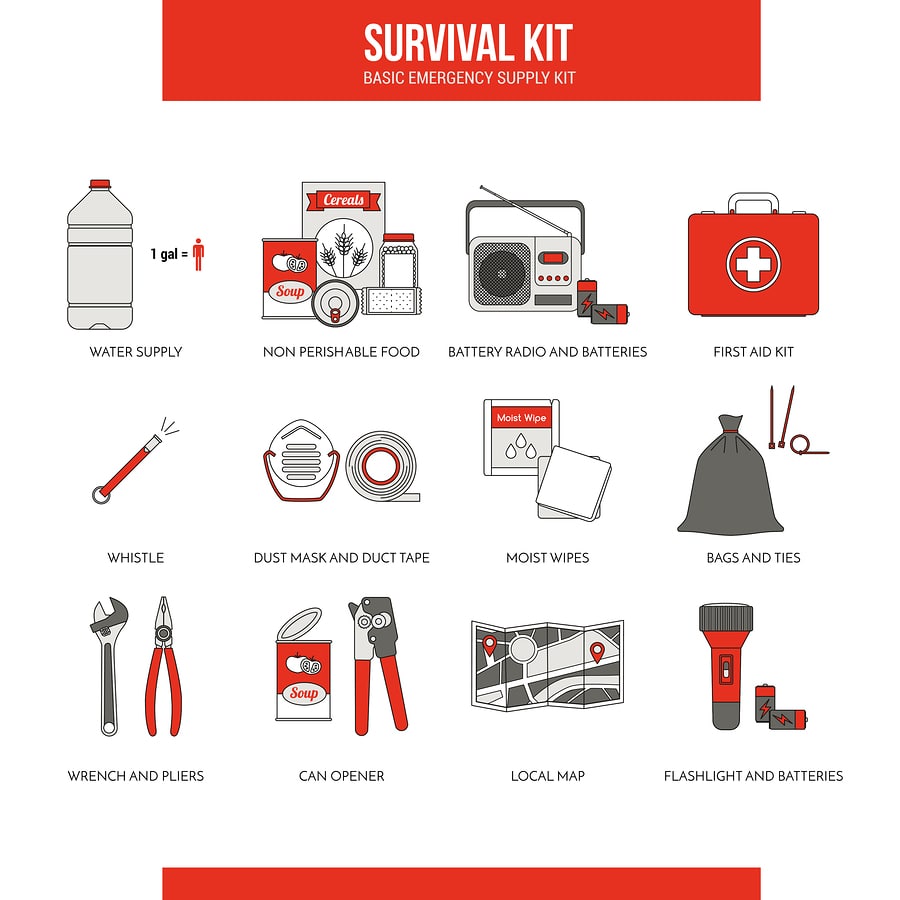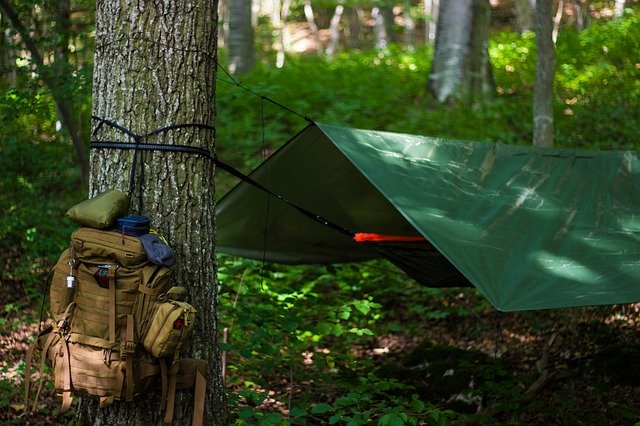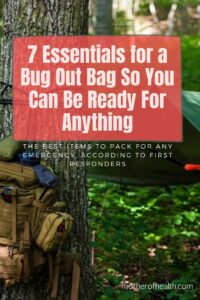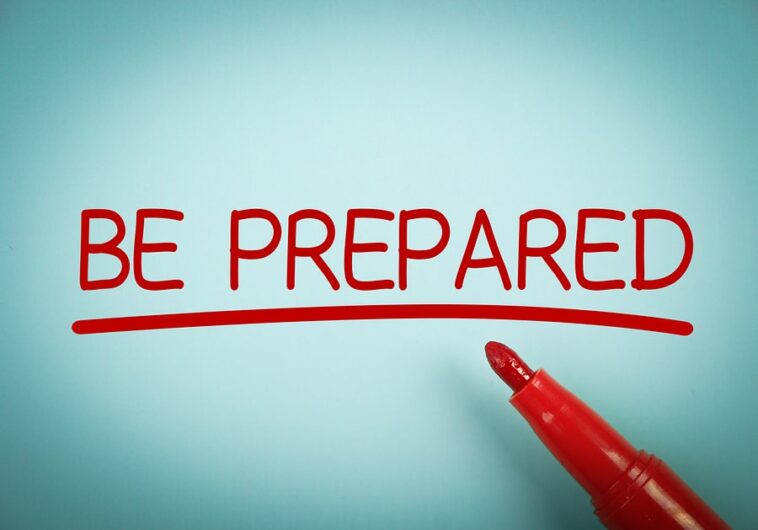7 Essentials for a Bug Out Bag
1. Water
Since we cannot last more than 3 days without water, hydration is your top priority. But water is heavy and carrying a few liters of freshwater may not be convenient. This is why you should include a water filtration device.
The best strategy is to pack both drinking water and items to help you gather and purify water. To ensure you get the hydration you'll need include these items:
- Drinking water (at least 3 liters per person)
- Water filtration system
- Water purification tablets
- Sturdy water bottle or canteen
2. Non-perishable foods
Although you can last up to 3 weeks without food, it’s best to pack some high-energy foods to keep you sustained and alert. The longer the shelf life and the higher the energy value, the better. Low-calorie foods that fail to keep you energized are a bad choice, as well as foods that can easily go bad.
It's also a good idea to pack some basic utensils in case you need to catch and/or prepare food when your supply is low. To avoid starving, add to your bag a combination of non-perishable foods and tools like these:
- Energy bars
- Dried fruits
- Jerky
- Dried Meals
- Cooking Pot or Skillet
- Spork and a knife
3. First Aid Kit
A bug out bag without a first aid kit isn’t a bug out bag at all. If you’re not prepared for potential medical emergencies and don’t have the essentials to treat injuries at the ready, everything else you packed won’t do you any good. Even the smallest wounds are a disaster waiting to happen. Without proper treatment, you’ll risk infection and sometimes life-treating complications.
The best way to make sure you’ll be able to have everything under control if a disaster strikes is to have a good first aid kit handy. This way, no matter the circumstances, you’ll be able to help yourself or your family members to stay alive and well.
When it comes to first aid kits, it’s always best to put them together yourself, but make sure you have your basics covered. Some of the items that are a must-have for first aid kits are:
- Wound closure strips and adhesive bandages
- Sterile gauze
- A suture kit
- Antibiotic ointment
- Pain relievers and anti-inflammatory drugs
- Over the counter antibiotics
- Hydrogen peroxide
- Rubbing Alcohol
- Sharp scissors and tweezers
Although not first aid per se, it’s good to include personal hygiene items along with your first aid kit. Nothing too fancy or over the top – a bar of soap, toothpaste and toothbrush, and some toilet paper are the basics. Ladies will want to include some tampons or maxi pads.

4. Clothing
A change of clothes might be the only thing keeping hypothermia at bay and helping you get through the critical period. The worst thing that could happen is for you to stay in wet clothes. You will need to have some extra layers to keep you warm and comfortable if the temperature drops.
Choose the textile materials for your clothing wisely. You want durable and heat-regulating materials like GorTex, Neoprene, Nettle fibers, or even wool.
Proper footwear will be comfortable for hiking and prolonged periods of time spent on foot, as well as being warm and allowing your feet to breathe. Here are some clothing items you should include if possible:
- Wool socks
- A pair of sturdy boots or quality walking shoes
- Long-sleeved shirt and a baseball cap for sun protection
- Pair of cargo pants
- A raincoat
- Underwear
- Wool sweater or a fleece jacket
5. Shelter

Sure, you might find packing shelter a tad excessive, but having protection from the elements and a safe place to rest and recuperate will significantly increase your chances of survival.
The bug out bag is supposed to be designed to help you get through the first 72 hours in case of emergency. So it’s wise to include at least something that can help you create a temporary shelter, in case you don’t find shelter in nature.
Sometimes, you won’t be able to even find some materials along the way to help you to quickly create one, so the compact shelter from your bug out bag can literally be a lifesaver.
If you have enough space in your bug out bag, include bedding also- a good night of sleep will help both your mind and body to perform at their peak. For lightweight and practical shelters, choose some of these items:
- Tent
- Tarp
- Hammock
- Sleeping bag
- Blanket
6. Basic Tools
It is important to have some useful tools to help increase your chances of survival. You should always count on circumstances where you won’t be able to access a power source.
Choose tools that will be useful no matter the conditions you find yourself in. The right tools can be indispensable in times of need. Whether it’s to help you find your way, start a fire, or to help you tackle the challenges of the terrain, without proper tools, your bug out bag won’t be of much help.
Some items you should definitely have in your bug out bag include:
- Fire-starting items (lighters, tinder, fire striker)
- Light source (LED lamp or headlamp, glow stick or a LED flashlight)
- Multi-tool or Swiss knife
- Compass
- Small knife
- Parachute Cord
7. Items for Self-Defense
If your mind is jumping to a zombie apocalypse scenario, and you think that packing something for your own self-defense might not be necessary in case of more plausible scenarios, you’re sorely mistaken.
Having something to defend yourself or your family is essential to have in emergency situations. You never know when you’ll need to protect yourself or your loved ones. When the time for bugging out comes, all bets are off on how other people will behave. And even if you end up not needing a weapon to protect yourself and your family from other people, chances are you might find them handy for fighting off wild animals (or even hunting food) in the rural areas, or even just for an added sense of security.
Avoiding trouble is the best strategy, but it doesn’t hurt to be prepared to defend yourself. Either way, you’ll be glad to have something for self-defense in your bug out bag in any of the many plausible scenarios. Depending on the laws and regulations of your country, here are some items for self-defense you might consider packing:
- Gun
- Rifle
- Pepper Spray
- Machete
- Taser
- Ammunition
Some Non-Essential Items to Consider
We’ve listed 7 essential things every bug out bag must have. But, it doesn’t mean these are the only items you should have in your bug out bag.
Depending on your own personal skillset and surroundings, you might want to include some extra items that could be of tremendous help in unforeseen emergencies.
Or you may want to substitute some of our own suggestions with something more suitable for your own individual bug out plan.
For example, if you’re living in an urban area, it wouldn’t hurt to include a gas mask in case of terrorist attacks and airborne contaminants.
Or if you’re in an area that has a lake or a river, include fish hooks or rods, to help you catch fish and supplement your food.
A good bug out bag is created with a concrete bug out plan in mind. The essentials we specified are must-have items. But as for additional items that could be extremely useful to have, it’s all up to you.
Nobody knows your surroundings and personal abilities better, so use your own knowledge to your advantage. Being prepared for unexpected situations is the key to survival. And a bug out bag packed with essentials and customized additions is a sure way to be few steps ahead of everyone in case of any kind of emergency.
Our list of universally useful non-essential items to pack includes:
- Hand-cranked radio
- Map
- Emergency radio
- Duct tape
- Bandana
- Batteries
- Binoculars
- Sewing Kit
- Whistle
- Signal Mirror
- Insect Repellent
- Portable Stove
Emergency Preparedness and the Importance of Bug Out Plan
Bug out bag’s sole purpose is to keep you alive for 72 hours, in case you need to leave everything behind and evacuate your home. In cases of these emergencies, you’ll have to act fast and it’s important to keep your bug out bag somewhere easily accessible at all times.
Before you even think about making your own bug out bag, you’ll need to come up with a solid bug out plan to ensure you’ll be prepared for everything and anything.
You don’t have to let your imagination run wild to come up with a scenario that would require you to evacuate. Natural disasters, riots, and civil unrest are now common occurrences. They can happen anytime and force you to fend for yourself.
Although the ideal situation would be to hunker down in your own home, sometimes this just isn’t the option. This is why it’s essential to come up with a bug out plan that is reliable and easily adapted to different scenarios.
When you factor in the possible disaster characteristic for your area, advantages, and disadvantages of the terrain and your surroundings, you’ll have everything you need to plan out your bug out plan and bag.
If you really want to up your game, create more than one bug out bag per person. Keep one in your car, your workplace, and your home. This way, you won’t risk finding yourself without your bug out bag when the disaster strikes. And, even if you end up not needing to evacuate, but rather stay at your home, essential survival items you packed will surely be more than useful.
Choosing A Bug Out Bag



